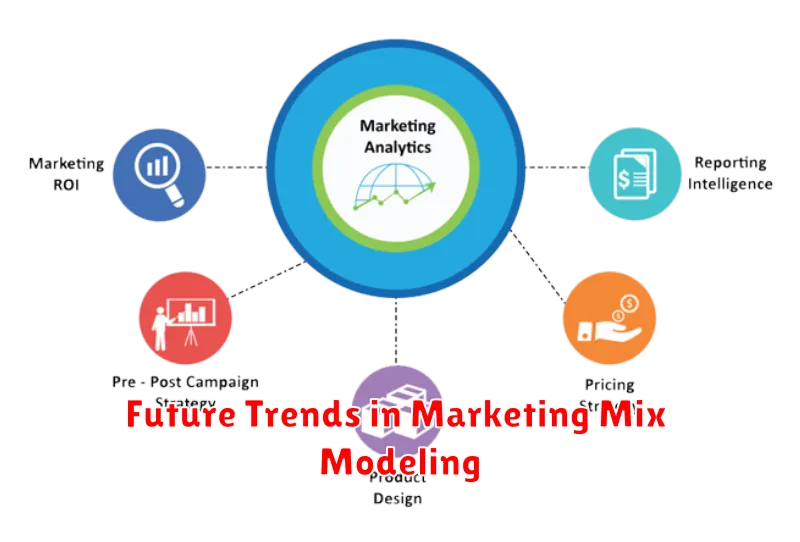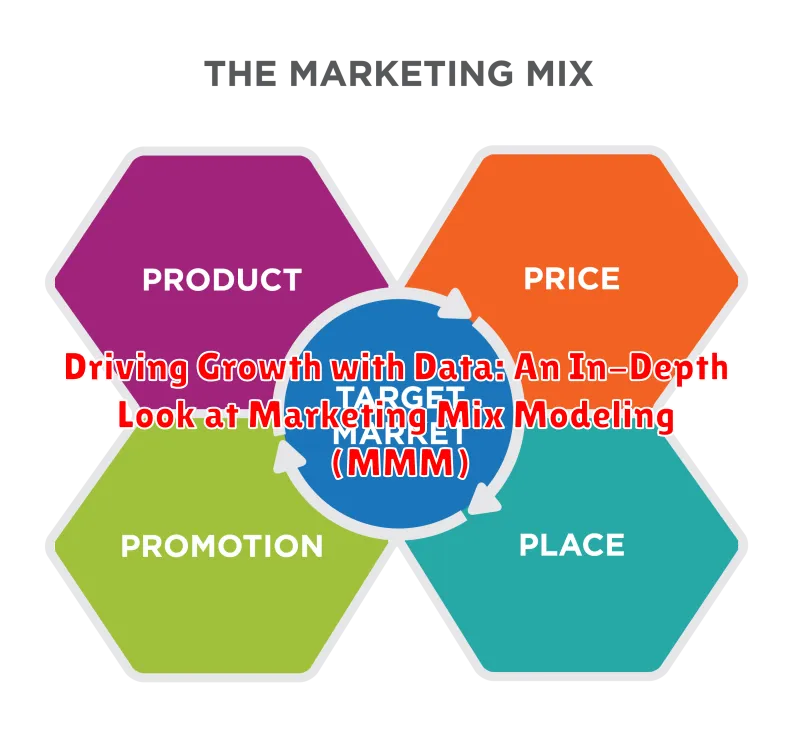In today’s hyper-competitive business landscape, achieving sustainable growth requires a data-driven approach. Companies are increasingly turning to sophisticated analytical techniques to optimize their marketing strategies and maximize return on investment (ROI). Among these techniques, Marketing Mix Modeling (MMM) stands out as a powerful tool for understanding the complex interplay of various marketing channels and their impact on overall business performance. This article provides an in-depth look at MMM, exploring its core principles, methodologies, and practical applications in driving growth.
This comprehensive guide to Marketing Mix Modeling will delve into how businesses across various industries can leverage this analytical framework to make informed decisions about their marketing spend. We will examine the key components of an effective MMM strategy, including data collection, model building, and interpretation of results. Furthermore, we will explore how MMM can be used to optimize marketing budgets, identify high-performing channels, and ultimately drive growth in a measurable and sustainable manner. Prepare to discover how data can be transformed into a strategic asset for achieving significant marketing ROI.
What is Marketing Mix Modeling (MMM)?
Marketing Mix Modeling (MMM) is a statistical analysis technique used to measure the past effectiveness of marketing activities. It leverages historical sales data and marketing spend to quantify the impact of various marketing elements on sales and revenue.
Essentially, MMM helps businesses understand which marketing efforts are driving the most significant returns. It provides a holistic view of marketing performance, considering the interplay of different channels, such as:
- Traditional Advertising: TV, radio, print
- Digital Marketing: Paid search, social media, display ads
- Promotions: Discounts, coupons, special offers
- Other Factors: Pricing, seasonality, economic conditions
By analyzing this data, MMM helps companies optimize their marketing budgets and allocate resources more effectively. It enables data-driven decisions about future marketing campaigns, leading to improved ROI and business growth.
The Benefits of Implementing MMM for Your Business
Implementing Marketing Mix Modeling (MMM) offers a multitude of benefits for businesses seeking to optimize their marketing investments and drive substantial growth. By providing a holistic view of marketing performance, MMM empowers organizations to make data-driven decisions across various channels and campaigns.
- Improved Budget Allocation: MMM helps identify which marketing channels are most effective in driving sales and ROI, allowing for optimized budget allocation.
- Enhanced Forecasting: By analyzing historical data, MMM enables businesses to forecast future marketing performance and plan accordingly.
- Better Understanding of Channel Synergies: MMM uncovers how different marketing channels interact and influence each other, enabling businesses to leverage synergistic effects for maximum impact.
- Data-Driven Decision Making: MMM provides concrete evidence to support marketing decisions, reducing reliance on gut feelings and subjective opinions.
- Competitive Advantage: By optimizing marketing strategies based on data insights, businesses can gain a competitive advantage in the marketplace.
Ultimately, MMM allows businesses to maximize the return on their marketing investments and achieve sustainable growth by understanding the true impact of each marketing activity.
Key Components of a Marketing Mix Model
A robust Marketing Mix Model (MMM) is built upon several crucial components working in concert. Understanding these components is key to effectively leveraging MMM for strategic decision-making.
Dependent Variable: This is typically a key performance indicator (KPI) that the model aims to explain and predict, such as sales, revenue, or market share. The choice of dependent variable directly influences the model’s focus and insights.
Independent Variables (Marketing & Control Variables): These include all the marketing activities (e.g., advertising spend across various channels, promotions, pricing) and control factors (e.g., seasonality, economic indicators, competitor actions) that are believed to influence the dependent variable.
Regression Analysis: Statistical techniques, primarily regression analysis, are used to quantify the relationship between the independent and dependent variables. This allows us to understand the impact of each marketing activity on the KPI.
Time Series Data: MMM relies on historical data collected over time, typically weeks or months. The length and quality of the time series data significantly impact the accuracy and reliability of the model.
Model Validation: After building the model, it’s crucial to validate its performance using holdout data or other validation techniques to ensure its predictive accuracy and robustness.
Data Sources Used in Marketing Mix Modeling
Successful Marketing Mix Modeling (MMM) relies on the integration of various data sources to provide a comprehensive view of marketing performance. These sources generally fall into the categories of internal and external data.
Internal data includes information readily available within the organization, such as:
- Sales data: Transaction records, revenue figures, and units sold.
- Marketing spend data: Budget allocation across different channels and campaigns.
- Pricing data: Changes in product pricing and promotional discounts.
- Website analytics: User behavior, traffic sources, and conversion rates from platforms like Google Analytics.
External data provides contextual information from outside the organization, including:
- Market research data: Consumer surveys, competitor analysis, and industry trends.
- Economic data: GDP, inflation rates, and unemployment figures.
- Media spend data (External Verification): Confirms media investments reported internally.
- Social media data: Brand mentions, sentiment analysis, and engagement metrics.
The quality and accuracy of these data sources are crucial for obtaining reliable MMM results. Data validation and cleansing are essential steps in the modeling process.
MMM vs. Attribution Modeling: Understanding the Differences
While both Marketing Mix Modeling (MMM) and Attribution Modeling aim to optimize marketing spend, they differ significantly in their approach and scope. MMM is a top-down approach that analyzes the impact of various marketing activities on overall sales and revenue, typically using aggregated historical data.
Attribution modeling, conversely, is a bottom-up approach that focuses on identifying which specific touchpoints in the customer journey contributed to a conversion. It uses granular data to assign credit to each interaction.
Here’s a quick comparison:
- MMM: Macro-level analysis, focuses on overall impact, uses historical data, suitable for strategic planning.
- Attribution Modeling: Micro-level analysis, focuses on individual customer journeys, uses real-time data, suitable for tactical optimization.
In essence, MMM provides a broader understanding of marketing effectiveness, while attribution modeling offers a more detailed view of customer behavior. Choosing the right model depends on the specific goals and data availability.
Steps Involved in Building a Marketing Mix Model

Building a robust Marketing Mix Model (MMM) involves a structured, multi-stage process. This ensures the model accurately reflects the impact of various marketing activities on sales or other key performance indicators (KPIs).
1. Define Objectives and KPIs: Clearly establish the business goals you want to achieve with MMM and identify the key performance indicators (KPIs) that will be measured. Examples include sales, revenue, or market share.
2. Data Collection and Preparation: Gather historical data on all relevant marketing activities, sales, and external factors. Clean and transform the data to ensure consistency and accuracy.
3. Model Specification: Choose the appropriate statistical model based on the data characteristics and business objectives. Common techniques include multiple regression, time series analysis, and Bayesian models.
4. Model Calibration and Validation: Estimate the model parameters using historical data and validate the model’s accuracy by comparing its predictions with actual results. Fine-tune the model as needed.
5. Scenario Planning and Optimization: Use the calibrated model to simulate the impact of different marketing scenarios. Identify the optimal allocation of marketing resources to maximize ROI.
6. Implementation and Monitoring: Implement the recommended marketing plan and continuously monitor the model’s performance. Update the model with new data to maintain its accuracy and relevance.
Interpreting MMM Results: What Insights Can You Gain?
Interpreting Marketing Mix Modeling (MMM) results provides businesses with actionable insights to optimize marketing strategies and drive growth. The core output of MMM is quantifying the impact of each marketing channel on key performance indicators (KPIs) such as sales, revenue, or brand awareness.
Specifically, understanding the Return on Investment (ROI) for each channel allows for strategic budget allocation. Channels with high ROI should receive increased investment, while underperforming channels may require optimization or reallocation.
Furthermore, MMM reveals the incremental impact of each marketing activity, allowing businesses to assess the true value of their campaigns. It also identifies the synergistic effects between different channels, uncovering opportunities for integrated marketing strategies. Insights into the lagging effects of marketing activities help in forecasting future performance and planning long-term strategies.
Beyond channel performance, MMM can also uncover valuable insights into customer behavior and preferences, informing segmentation and targeting strategies. Finally, it aids in scenario planning, allowing businesses to predict the impact of different marketing scenarios on key metrics.
Tools and Technologies for Marketing Mix Modeling
The implementation of Marketing Mix Modeling (MMM) relies heavily on a variety of tools and technologies that facilitate data collection, processing, and analysis. Choosing the right tools is crucial for the accuracy and efficiency of the modeling process.
Statistical Software Packages
Statistical software packages such as R, Python (with libraries like statsmodels and scikit-learn), and SAS are frequently used for conducting regression analysis, time series analysis, and other statistical techniques necessary for MMM.
Data Visualization Tools
Data visualization tools, including Tableau and Power BI, are instrumental in presenting MMM results in a clear and understandable format, allowing stakeholders to easily grasp key insights and trends.
Cloud Computing Platforms
Cloud computing platforms, such as Amazon Web Services (AWS), Google Cloud Platform (GCP), and Microsoft Azure, offer the computational power and storage capacity needed to handle the large datasets often associated with MMM.
ETL Tools
Extract, Transform, Load (ETL) tools play a vital role in consolidating data from diverse sources into a unified format suitable for MMM. Tools like Apache Kafka, Apache Spark, and Informatica are commonly employed.
Challenges in Implementing and Maintaining MMM
Implementing and maintaining Marketing Mix Modeling (MMM) presents several challenges that organizations must address for effective results. One primary hurdle is data availability and quality. MMM relies on comprehensive historical data, and incomplete or inaccurate data can significantly skew the model’s output.
Another challenge is model complexity. Building a robust MMM requires advanced statistical expertise and an understanding of various econometric techniques. Organizations may need to invest in skilled personnel or external consultants to develop and maintain the model.
Furthermore, data integration can be complex. MMM often involves integrating data from diverse sources, such as advertising platforms, sales databases, and economic indicators. Ensuring seamless data integration and consistency can be technically challenging.
Lastly, keeping the model up-to-date is essential. Market dynamics and consumer behavior evolve over time. Regularly recalibrating the model with fresh data and updated techniques is crucial to maintain its accuracy and relevance.
Future Trends in Marketing Mix Modeling

The landscape of Marketing Mix Modeling (MMM) is rapidly evolving, driven by technological advancements and the increasing complexity of marketing channels. We anticipate several key trends shaping the future of MMM.
Enhanced Granularity and Real-Time Insights: Future MMM solutions will likely incorporate more granular data, enabling marketers to understand the impact of specific campaigns and tactics in near real-time. This shift will allow for more agile and responsive marketing strategies.
Integration of Advanced Analytics: Expect to see greater integration of machine learning and artificial intelligence (AI) to automate model building, improve accuracy, and uncover hidden patterns in marketing data. This includes utilizing AI for feature engineering and identifying optimal media allocation strategies.
Focus on Incrementality: Future MMM will place a stronger emphasis on measuring the true incremental impact of marketing activities. This means isolating the causal effect of each channel, rather than simply correlating spend with sales. More sophisticated causal inference techniques will be utilized.
Cross-Functional Collaboration: MMM insights will increasingly be used to inform broader business decisions beyond marketing, fostering greater alignment between marketing, sales, and product development teams.

